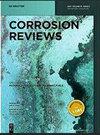Corrosion inhibition efficiency and quantum chemical studies of some organic compounds: theoretical evaluation
IF 2.7
4区 材料科学
Q3 ELECTROCHEMISTRY
引用次数: 2
Abstract
Abstract When most or all of the atoms on a single metal surface are oxidized, corrosion takes place, causing damage to the whole surface. The effects of adsorption and corrosion inhibition on different types of functional groups were studied. A review of these inhibitors based on concentration effect was performed to establish the theoretical results. It has been investigated the effects of 5-(5-(3,5-diaminophenyl)-1,3,4-oxadiazol-2-yl)-N1,N3-di-p-tolylbenzene-1,3-diamine (BATP) on mild steel in 1 M H2SO4 at 30 °C, Levamisole (LMS) and 4-phenylimidazole (PIZ) on copper in 0.5 M H2SO4, 2-phenyl-1, 4-dihydroquinoxaline (PHQ) on carbon steel in 1.0 M HCl. Based on DFT calculations in the 6–311++G(d,p) basis set in gas and aqueous phases, several quantum chemical parameters were determined to evaluate the array of selected molecules such as HOMO, LUMO, ionization energy, bandgap energy, electronegativity, chemical potential, electrophilicity, nucleophilicity, electron transfer, back-donation energy and Fukui function analysis. The most stable low-energy adsorption configurations of the materials employed in this investigation on the Fe (110) surface were induced using Monte Carlo simulations.一些有机化合物的缓蚀效率和量子化学研究:理论评价
摘要当单个金属表面上的大部分或全部原子被氧化时,就会发生腐蚀,对整个表面造成损坏。研究了不同类型官能团的吸附和缓蚀作用。基于浓度效应对这些抑制剂进行了综述,以确定理论结果。研究了5-(5-(3,5-二氨基苯基)-1,3,4-恶二唑-2-基)-N1,N3-二对甲苯基-1,3-二胺(BATP)在1M H2SO4中30°C对软钢的影响,左旋咪唑(LMS)和4-苯基咪唑(PIZ)在0.5M H2SO4中对铜的影响,2-苯基-1,4-二氢喹喔啉(PHQ)在1.0M HCl中对碳钢的影响。基于气相和水相中6–311++G(d,p)基组中的DFT计算,确定了几个量子化学参数来评估所选分子的阵列,如HOMO、LUMO、电离能、带隙能、电负性、化学势、亲电性、亲核性、电子转移、回供能和福井函数分析。使用蒙特卡罗模拟诱导了本研究中使用的材料在Fe(110)表面上最稳定的低能吸附构型。
本文章由计算机程序翻译,如有差异,请以英文原文为准。
求助全文
约1分钟内获得全文
求助全文
来源期刊

Corrosion Reviews
工程技术-材料科学:膜
CiteScore
5.20
自引率
3.10%
发文量
44
审稿时长
4.5 months
期刊介绍:
Corrosion Reviews is an international bimonthly journal devoted to critical reviews and, to a lesser extent, outstanding original articles that are key to advancing the understanding and application of corrosion science and engineering in the service of society. Papers may be of a theoretical, experimental or practical nature, provided that they make a significant contribution to knowledge in the field.
 求助内容:
求助内容: 应助结果提醒方式:
应助结果提醒方式:


